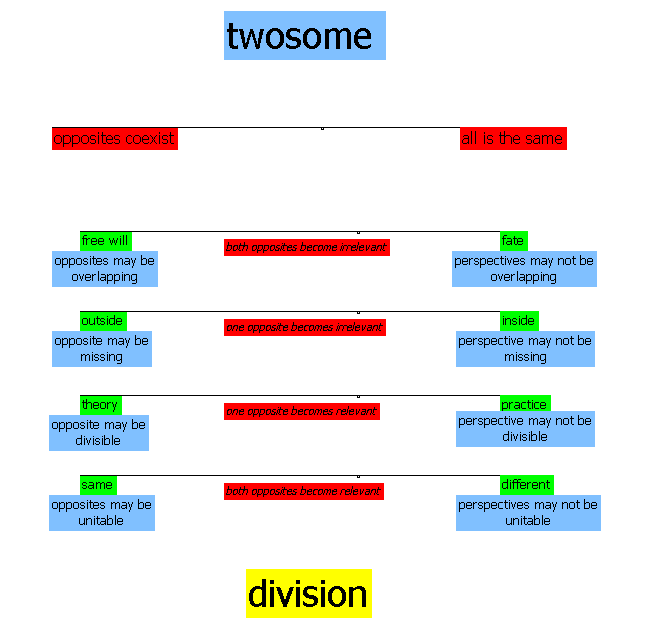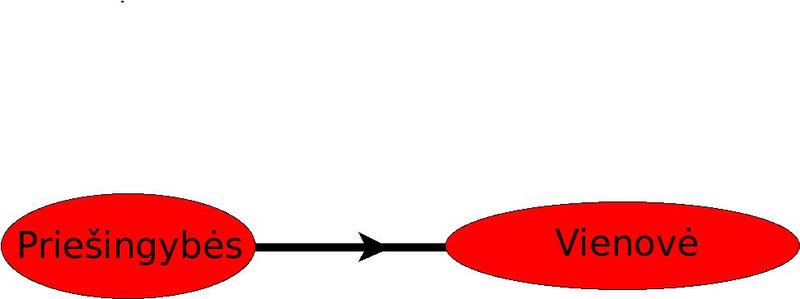Padalinimai, Padalinimų ratas, Abėcėlė, Trejybė, Ketverybė, Požiūriai, Veiksmas +2, Požiūrių sudūrimas, Išvertimas
Kaip nusakyti dvejybę?
二切
- Ar dvejybė veda iš žinojimo-nežinojimo į troškimą?
- Kuris dvejybės atvaizdas yra: klausimas-atsakymas ?
Kas yra buvimas
- Dievas yra.
Koks yra buvimas
- Buvimas yra būklėje. Tai būties klausimas, dvejybės klausimas, atskyrimas buvimo ir būklės, tad suvokimo ištakos.
- Dvejybe, buvimu, Dievas apibrėžiamas neigiamai, kaip neturintis prielaidų.
- Dvejybė išverčia Dievo pristatymą.
- Buvimas yra dvejybinis.
- Priešingos pusės (gretinamos) turi bendrų prielaidų (kuriais viskas visvien).
Krypties apvertimas
The reversal effect is the idea that, upon reflection, the direction of a representation of the {{Twosome}} changes. So, for example, the perspective of free will leads into the perspective of fate, and not the other way around. However, there is a reversal effect: Thinking about fate leads to thinking about free will, and not the other way around.
The reversal effect may be related to the switching around of a composition. For example, we would like to switch from a bounded view of an unbounded view to an unbounded view of a bounded view.
This might also relate to the relationship between {{Structure}} and {{Activity}} as given by the [AddTwo operation +2].


See also: {{Divisions}}, RepresentationsOfTheTwosome
===The Twosome - The Division of Everything into Two Perspectives===
The twosome is the [DivisionsOfEverything division of everything] into two perspectives. This structure defines issues of existence. The two perspectives are one where opposites coexist, and another where all things are the same. Our mind moves from the perspective where opposites coexist to the perspective where all things are the same. The twosome has four representations: +3) free will and fate, +2) outside and inside, +1) theory and practice, +0) same and different. [10/99, Andrius Kulikauskas]

See also: Twosome, Existence
Being, Existence
- be separate
- independent
- separate from God
- prior to God
- is confusing to define, both as being separate or not, and as BeingOneWith
- is the satisfying of a definition
- is the taking up of a vantage point
- is subsequent to System, is not beyond it, and is relevant in it negatively as NotBeing
- is a topic shared by Persons. Logical statements have to do with saying that "there exists" or that "for all" regarding some quality.
- what is assumed, the relationship between one (independent, distinct identity) and one's self (dependent, contextual identity), the sharing of a frame, the projection of the Referer (sharer) frame within the Referent (shared) frame as its NullActivity, thus allowing for a shared frame (being) for both Referer (as body) and Referent (as thing), independence of conditions, definiteness of being alone, being alone within a context (where there can be not being, thus an absolute set of relationships for references, thus a scope), satisfying a definition of being alone, the distinction of God's going beyond himself and going into himself, the distinction (within Scope by NotGod) of being alone (Being) from not being alone (NotBeing), the distinction of Questions and Answers, independent being, independence of System, thus relation with what is beyond System including NotBeing, expression as Position, the taking up of Answers, thus the Activity of being separate, being without Self, beyond one's Self. Being and NotBeing are the same beyond Scope (for God as Self (NotGod, Everything, Lack of self) derives unconditionally). Being and NotBeing are distinct as Person for NotGod because God derives from Self conditionally. (GoingBeyondOneself, Divergence, Distinction, Division).
What is the meaning of presence and absence, affirmation and negation, being and not being? especially with regard to a channel – full or empty – between what is completely beyond and what is completely within.
Nonbeing
- is to depend on Scope
- is the ways that a Person can exist, can be separate from God
- is the Scopes with regard to which a Person is defined
- is the distinction of what allows (for nonexistence; God) and what is allowed (as nonexistence; NotGod)
- is expressed in terms of Scope and Person.
- is the lack of relationship between one and one's self, the nonsharing of a frame, dependence on conditions, on System, indefiniteness (lack of distinction) of being alone or not, separation from Being, expression as Perspective, the not taking up of Answers, being with Self, in one's Self.
Being and NotBeing
- conflict with each other only if their coinciding is imposed upon a person. So that they are compared but not through him, thus making irrelevant his comparison.
- are defined with regard to the system or beyond it?
- are the same for God (for whom they are completely separate), and also the same for Other (for whom they are completely the same)
God's Being
- is his LackOfSelf, going without self, being separate from himself, self-negation
- is his going beyond himself
- is his unconditional BeingAlone
- in nonexistence is Activity evoking Structure, and Structure links a Scope with the other scopes.
- is a matter of each Person's existence, in that they are prior to the arisal of God
- is the potential of God
- is his giving up himself, negating himself, his unconditional being Alone
God's Being and NotBeing
- are the same because God is his own Self
- are his self-negation and self-affirmation, respectively
- are simply words and he is the only reference point for them... so how do other reference points arise for words?
- go hand in hand, for God (nonbeing) stands apart from anyself, yet (being) thereby is related to his self and plays off this relationship
- Būtis yra išskyrimas: "būtis" ir ... anas
- Teorija yra dvilypis požiūris, analitinis, sąmonės, o praktika yra vienlypis, sintetinis, pasąmonės. Praktika yra kurios nors gyvenimo srities (kaip, koks), o teorija yra visų sričių (kodėl, ar).
- Albinas: Nuo genijaus iki bepročio vienas žingsnis, o atvirkštinis kelias kur kas ilgesnis.
Dvejybės atvaizdai
There are four representations of the division of everything into two perspectives. Such a division has two perspectives: one where opposites coexist, and another where all things are the same. I know of only four ways of conceiving such a division:
- "free will" and "fate"
- "outside" and "inside"
- "theory" and "practice"
- "same" and "different"
For example, if I am outside a system, then it also has an inside, and so opposites coexist. But if I am sucked inside that system, then there is only inside, as in that we are inside our universe. Likewise, if items are the same, then they must also be different in that they are distinct. But if they are different, then they are simply different. So these are "representations" of an underlying structure, the division of everything into two perspectives.
Užrašai
- Kaip savastis susijusi su dvejybės atvaizdais, pavyzdžiui, su skirtumu tarp sąlygiškumo ir besąlygiškumo ir t.t.?
- "You can't have your cake and eat it, too." Dvejybė - galimybė (turėjimas) ir esamybė (suvalgymas).
- Dvejybė: žinojimas-nežinojimas ir troškimas (o kaip su netroškimu?)
- Pamąstyti kaip dvejybės atvaizduose priešingybės susijusios su pasirinkimu. Pavyzdžiui, laisvoje valioje - likime pirma išsiskiria priešingybės, o paskui renkamės. Tuo tarpu tapatume - skirtingume nėra pagrindo rinktis - pasirinkimas yra vienodas - ir tik paskui išsiskiria. Arba išorėje - viduje pasirinkus viskas pasikeičia. Teorijoje - praktikoje kaip yra?
- https://en.wikipedia.org/wiki/Unity_of_opposites
- https://www.britannica.com/topic/table-of-opposites
- http://www.sfu.ca/~jeffpell/Phil350/Opposites.pdf
- Atsiradus skirtumui, turi dar prieš tai būti stebėtojas, galintis atskirti. Taip suprasti Spencer-Brown.
Laisvą valią grindžia ištrynimas, kaip kad Turingo mašina. Yra įvairių būdų nusigauti į tą pačią būseną ir nėra vieno kelio kaip grįžti atgal.
- Laisvą valią grindžia taip pat pasirinkimas iš trijų būsenų - nusistatymo, vykdymo, permąstymo.
- Laisva valia taip pat reiškiasi tuo, kad mes patys sprendžiama kada imtis trejybės rato poslinkio, ankščiau ar vėliau.
- Laisva valia reiškiasi mūsų pasirinkimu, ar gyventi Dievu ar savimi. Tai dviprasmybė į kurią susitelkia Jėzus.
Dvejybės atvaizdai skiria priešingybių rūšis: dvynių, pažymėtos-nepažymėtos ir t.t.Dvejybės atvaizdai skiria priešingybių rūšis: dvynių, pažymėtos-nepažymėtos ir t.t.
Immanuel Kant, Critique of Judgment (Wikipedia) The Critical project, that of exploring the limits and conditions of knowledge, had already produced the Critique of Pure Reason, in which Kant argued for a Transcendental Aesthetic, an approach to the problems of perception in which space and time are supposed not to be objects but ways in which the observing subject's mind organizes and structures the sensory world. The end result of this inquiry is that there are certain fundamental antinomies in human Reason, most particularly that there is a complete inability to favor on the one hand the argument that all behavior and thought is determined by external causes, and on the other that there is an actual "spontaneous" causal principle at work in human behavior.
- The first position, of causal determinism, is adopted, in Kant's view, by empirical scientists of all sorts; moreover, it led to the Idea (perhaps never fully to be realized) of a final science in which all empirical knowledge could be synthesized into a full and complete causal explanation of all events possible to the world.
- The second position, of spontaneous causality, is implicitly adopted by all people as they engage in moral behavior; this position is explored more fully in the Critique of Practical Reason.
Lietuvių kalba skiria tarp esančiojo ir būnančiojo. Esantysis yra (ar nėra) tam tikrose, vieningose aplinkybėse, o būnantysis jose pabūna, užtat tai nevieningos aplinkybės. Esantysis, tai griežtėjantis klausimas: yra ar nėra? O būnantysis, tai minkštėjantis atsakymas - yra kaip yra. (Tad kaip su laisvumu?) Esimas - tai esatis, kaip nuoroda, o buvimas - tai būtis, kaip būsena. Esantysis yra Dasein, o būnantysis yra Das Man. Panašiai, ispanų kalba skiria estar ir ser.
Pavyzdžiai
{{Andrius}}: ChrisopherLangan writes of Syndiffeonesis, difference-in-sameness, that when things are different, then that implies that there is a reality in which they are the same, as they are comparable. I think this is very noteworthy, however, I think it still constitutes a switch in direction, it is not the straightforward direction. It requires a mental leap.